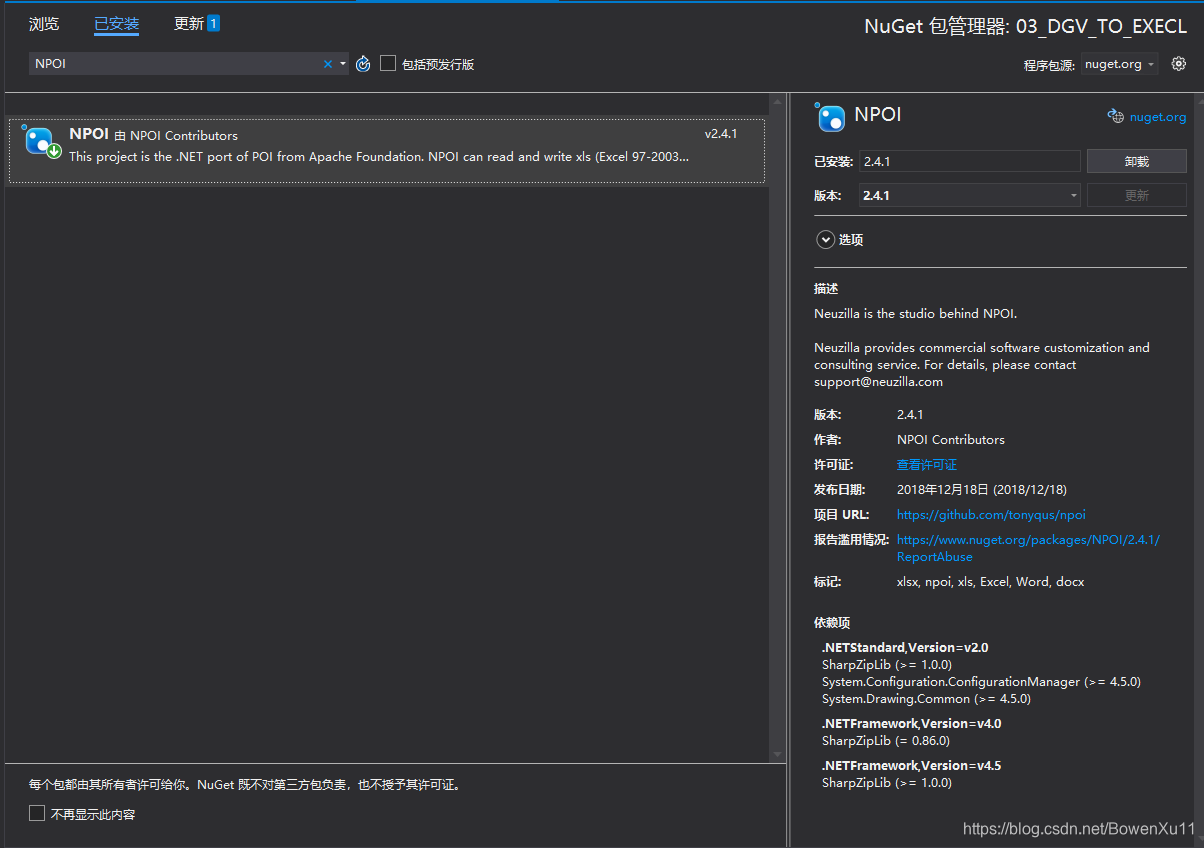今天用到了从datagridview到excel的导出功能。
发现NOPI的控件十分好用。
整理一下,方便自己以后使用。也方便大家使用。
这里使用的是NOPI,从nuget管理器获取


封装好的excelhelper,这里只需要传两个参数,文件的全路径和datagridview对象,就可以导出成excel
using NPOI.HSSF.UserModel;
using NPOI.SS.UserModel;
using System;
using System.Collections.Generic;
using System.IO;
using System.Linq;
using System.Text;
using System.Threading.Tasks;
using System.Windows.Forms;
namespace _03_DGV_TO_EXECL
{
public static class NPOI_DGVtoExcel_helper
{
public static int SaveToExcelNew(string filePath, DataGridView dataGridView)
{
//int 记录返回结果1.导出成功 2.文件重名 3.错误信息 0.成功 4.行数超过excel文件限制
int result;
FileStream fs = null;//创建一个新的文件流
HSSFWorkbook workbook = null;//创建一个新的Excel文件
ISheet sheet = null;//为Excel创建一张工作表
//定义行数、列数、与当前Excel已有行数
int rowCount = dataGridView.RowCount;//记录表格中的行数
int colCount = dataGridView.ColumnCount;//记录表格中的列数
//为了防止出错,这里应该判定一下文件与文件是否存在
// if (File.Exists(filePath))
//{
// return 2; //这里简单的只写了返回一个值,表示文件已经存在,不要覆盖。
//感兴趣的,可以自己写一个自动改名代码,避免覆盖的同时,还可以将文件自动另存。
//}
//创建工作表
try
{
fs = new FileStream(filePath, FileMode.Create, FileAccess.Write);
workbook = new HSSFWorkbook();
sheet = workbook.CreateSheet("Sheet1");
IRow row = sheet.CreateRow(0);
for (int j = 0; j < colCount; j++) //列循环
{
if (dataGridView.Columns[j].Visible && dataGridView.Rows[0].Cells[j].Value != null)
{
ICell cell = row.CreateCell(j);//创建列
cell.SetCellValue(dataGridView.Columns[j].HeaderText.ToString());//更改单元格值
}
}
}
catch
{
result = 3;
throw;
return result;
}
for (int i = 0; i < rowCount; i++) //行循环
{
//防止行数超过Excel限制
if (i >= 65536)
{
result = 4;
break;
}
IRow row = sheet.CreateRow(1 + i); //创建行
for (int j = 0; j < colCount; j++) //列循环
{
if (dataGridView.Columns[j].Visible && dataGridView.Rows[i].Cells[j].Value != null)
{
ICell cell = row.CreateCell(j);//创建列
cell.SetCellValue(dataGridView.Rows[i].Cells[j].Value.ToString());//填充单元格值
}
}
}
try
{
workbook.Write(fs);
result = 1;//成功
}
catch
{
result = 3;
return result;
}
finally
{
if (fs != null)
{
fs.Close();
fs.Dispose();
}
workbook = null;
}
return result;
}
}
}
创建一个SaveFileDialog控件对象,拿到一个全路径
调用的代码
private void button2_Click(object sender, EventArgs e)
{
//创建和初始化一个SaveFileDialog
SaveFileDialog sfd = new SaveFileDialog();
sfd.Title = "导出Excel文件";//标题
sfd.Filter = "Excel(*.xls)|*.xls";//设置文件类型
sfd.FileName = "新建excel";//设置默认文件名
sfd.DefaultExt = "xls";//设置默认格式(可以不设)
sfd.AddExtension = true;//设置自动在文件名中添加扩展名
if (sfd.ShowDialog() == DialogResult.OK)
{
int r= NPOI_DGVtoExcel_helper.SaveToExcelNew(sfd.FileName, dataGridView1);//调用NPOI_DGVtoExcel_helper
switch (r)
{
//int 记录返回结果1.导出成功 2.文件重名 3.错误信息 0.成功 4.行数超过excel文件限制
case 1: MessageBox.Show("导出成功:" + sfd.FileName);
break;
//case 2:MessageBox.Show("文件已经存在");//启用这行代码就不会覆盖文件
// break;
case 4:MessageBox.Show("行数超过excel限制");
break;
default:
break;
}
}
}
就这么简单,几乎不用写代码,就实现了导出excel。不用恶心的调试各种office的问题。很实用。推荐。
